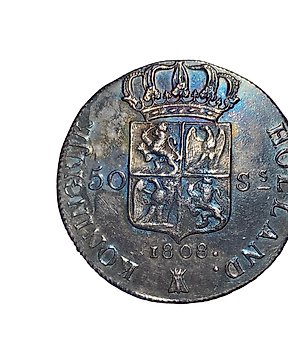
Niederlande, Holland. 50 stuivers 1808
Nr. 82025941

Nr. 82025941

Leeuwendaalder (Lion Dollar) 1650, Province of Holland (Dutch Republic)
Catalogus Nederlandse Munten 2.28.68
Delmonte 832
27 grams .750 silver
Diameter 40 mm
Obverse
Knight standing to left with head right, in armor and draped, wearing an ornate crest; in front of him a lion shield dividing legend.
Lettering: MO · ARG · PRO · CO FOE · BELG · HOL · (MOneta ARGentea PROvinciarum CONFOEdearatum BELGicarum, HOLland - "Silver money of the Province of the Netherlands Confederation, Holland")
Reverse
Rampant lion left inside beaded circle, date at top
Lettering: CONFIDENS · DNO · NON · MOVETVR · 1650 · (CONFIDENS DomiNO NON MOVETUR - "Those who trust in God are immovable")
Mint: Dordrecht, Holland
Several coins were produced in the Netherlands specifically to facilitate export trade. The most important of these coins was the lion dollar (the leeuwendaalder) which was first minted in the province of Holland in 1575 during their struggle for independence. Soon thereafter lion dollars were issued by six of the seven Dutch provinces, along with independent issues produced by some of the major cities.
The lion dollar was authorized to contain 427.16 grains of .750 fine silver and passed locally for between 36 to 42 stuivers. It was lighter than the large denomination coins then in circulation, namely the ducatoon (491 grains of .920 fine silver and passing at 3 guilders or 60 stuivers) and the rijksdaalder (448 grains of .885 fine silver passing at 2 1/2 guilders or 50 stuivers). Clearly it was more advantageous for a Dutch merchant to pay a foreign debt in lion dollars rather than in more costly rijksdaalders. Thus, the lion dollar became the coin of choice for foreign trade.
The lion dollar circulated throughout Eastern Europe and the Middle East and was imitated in several German and Italian cities. It was also popular in the Dutch East Indies. By the 1690s lion dollars were brought to British America by colonial merchant adventurers, slave traders, and pirates who undertook expeditions to East Africa and Madagascar. In the colonies lion dollars were sometimes referred to as "dog dollars" due to the pose of the lion resembling a dog standing up on its hind legs.
This coin was unearthed as part of a coin hoard in eastern Europe. More detailed information will be provided to the winner of the auction.
So kaufen Sie auf Catawiki
1. Etwas Besonderes entdecken
2. Höchstgebot abgeben
3. Sichere Zahlung durchführen